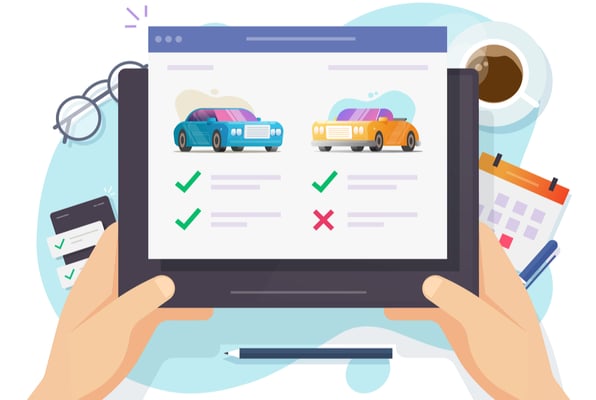Subscribe now and get the latest podcast releases delivered straight to your inbox.
Sell physical products virtually by focusing on 3 aspects of the buying process

Jan 4, 2021

Customers buying a physical product virtually want three things:
- To see the product in action
- To be able to mitigate risk
- To hear from other real buyers
If you ever have a doubt that physical products can be sold virtually, think back to the infomercials from the 80s and 90s.
Long before internet shopping took off, people willingly sent in money to buy products that promised to save time, make their lives easier, or just be fun to use — and these were products that the buyers had never touched, tested, or tried on.
What was it about these infomercials that made customers so comfortable with buying something they hadn’t experienced first hand? I think we can actually learn a few lessons from these relics from the past. They are a good reminder that people are willing to buy things sight unseen, provided that you can give them the right buying experience.
I’m not saying that you should adopt the cheesy salesiness of infomercials, but I think these sellers were on to something that has come to light again as people shift so much of their shopping to the internet, whether that’s because of the pandemic or not.
Because here’s the thing: virtual sales are here to stay, even after the pandemic passes.
And I believe that practically anything can be sold virtually. It’s all in knowing how.
🔎Related: Virtual selling tips: 8 video sales call secrets from the pros
The sales experience that virtual buyers want
For every product now sold virtually, there was once a chorus of people saying it couldn’t be done.
You can’t sell shoes virtually! You can’t sell furniture virtually! You can’t sell cars virtually! Well, you certainly can according to Zappos, Wayfair, and Carmax. Where others saw barriers, these companies saw opportunity.
The key to selling any product virtually — and again, I fully believe you can sell anything this way — is this: you just need to provide the buying experience your customers want. Too often, companies get hung up on the fact that they can’t provide the same buying experience virtually that they can face to face. That might be true, but you can’t just focus on the limitations of the platform.
I believe you can provide great value to your customers through virtual sales. In some ways, even more value than in-person sales.
So, instead of getting stuck up on the limitations, focus on providing a similar sales experience that provides value and minimizes customer concerns about buying virtually.
Buyers want three things in order to feel comfortable with virtual purchases.
1. Buyers want to see the thing in action
Seeing is believing. While there is no true equivalent to holding something in your hand, seeing it up close (and from as many angles as possible) is a close second.
Whatever you sell, show it — and show it in as many ways and angles as you can. It could be project management software, metal detectors, or recessed lighting. Anything can be demonstrated in video — and live video is even better.
This is why those infomercials were so effective. They showed a product getting used in different ways, over and over. Eventually, viewers started thinking, “yeah, I could picture myself using that.”
2. Buyers want to mitigate risk
One of the reasons Zappos has been so wildly successful is its buyer-friendly return policy. We all know what it’s like to wear shoes that don’t feel right. You can return shoes bought from Zappos for up to a year, provided they’re in unworn condition.
Buyers everywhere value great customer service — and this only intensifies for things bought virtually.
Think back to the infomercials: “Money-back guarantee.” “If you’re not satisfied, return it for a full refund.” These phrases make buyers feel as though they have a way out if their purchase is not satisfactory.
.jpg) At my pool company River Pools, we’ve been selling pools virtually, which in and of itself surprises a lot of people. Almost every step of our sales process has been shifted to virtual meetings and video calls. Offering buyers this easy, semi-touchless way to buy has increased our leads dramatically.
At my pool company River Pools, we’ve been selling pools virtually, which in and of itself surprises a lot of people. Almost every step of our sales process has been shifted to virtual meetings and video calls. Offering buyers this easy, semi-touchless way to buy has increased our leads dramatically.
In order to help mitigate risk for our buyers, we’ve offered refundable deposits, which is something we’ve never done before. If a customer gets a few steps into the buying process and finds that a pool won’t work for whatever reason, they can get their money back. And plenty of customers do. They ask for their money back — and we are okay with that.
It’s part of the virtual sales process, and we know that this policy ends up getting more prospects in the door because it mitigates risk. More people buy because of our refundable deposits, even though some do ask for refunds.
At the same time, you need to make sure to get as much essential information from your buyer as soon as possible. This is often overlooked aspect of risk mitigation. If you’re selling furniture, make sure the customer measures the width of their doorways so they know they can actually get that couch in their house. If you’re selling appliances, make sure the customer has the necessary amperage to support running that air conditioner.
If you don’t, you run the risk of buyers starting to feel invested before learning something won’t work, which leads to frustration on both ends.
3. Buyers want to hear from others
Never have reviews been more important than they are now. Customers want reviews of products and services, reviews of the customer experience, reviews of the return process.
Now is a time to lean into your reviews. Post them on your website. If they’re on neutral platforms like Yelp, Angie’s List, Facebook, or Google, engage with reviewers. Respond to positive and negative reviews by offering thanks — and taking ownership of shortcomings.
And, don’t forget to ask for customer feedback. The more reviews you have, the better. According to a study from Bright Local, consumers want to see more than 40 reviews before they trust the average star rating.
In infomercials, you’re sure to hear testimonials from satisfied customers, and this was a big part of the appeal.
Now, in 2021, we might be more jaded, knowing that phony reviews are all-too-common, but the formula works. Buyers want to see how people like them feel about the product or service.
Industries winning with virtual sales
There are so many companies and industries finding success by switching to virtual sales. We work with clients every day who sell a huge range of products, both B2B and B2C, who are embracing virtual selling, touchless sales, and self-selection tools. Companies are openly talking about these things on their websites and in their blogs, too.
Here are two industries that have more barriers to selling online than most, and are actually finding great success.
Real estate: Going online and renting an apartment, buying a home, or investing in property seems risky, but with robust virtual tours that feature 360-degree video customers can really feel like they’re walking through and looking around a property.
I think real estate is being influenced by disruptors like AirBNB — and it’s likely you will see more risk mitigation and reviews come into this buying process soon as well.
Used cars: Used car salespeople have long had the reputation for being pushy and untrustworthy. At the same time, a car purchase is one of the most expensive things most people ever buy. This makes the buying experience a tense and uncomfortable one.
 Online retailers like CarMax and Carvana offer return policies that help buyers feel more confident with making such a big purchase sight unseen. It’s almost like you’re getting the car for a seven-day test drive, and you can then bring it back if you’re not pleased.
Online retailers like CarMax and Carvana offer return policies that help buyers feel more confident with making such a big purchase sight unseen. It’s almost like you’re getting the car for a seven-day test drive, and you can then bring it back if you’re not pleased.
In reality, I would guess few buyers actually end up returning the cars once they have them — but the policy provides comfort and projects a customer-first mentality.
🔎Related: My best sales reps haven't hit their numbers all year: What do I do?
There are fewer barriers to selling virtually than you think
I like to remind our clients that virtual sales is still face-to-face sales — it’s just done over Zoom or another video platform. The process is less familiar to your sales team than you might think.
There are some essential best practices that need to be mastered before you can truly flourish with virtual sales, but the right training can get you up and running quite quickly.
Whatever you sell, whether product or service, whether B2B or B2C, there is sure to be a way to sell it virtually, and when you choose to see the opportunities instead of the barriers, you can begin to imagine how.
Just keep in mind the buying experience your customers want to have. If you can really make them feel like they can see your product, if you can mitigate their risk, and if you can connect them to others just like them, there’s likely no reason you can’t thrive with virtual sales.


Order Your Copy of Marcus Sheridan's New Book — Endless Customers!